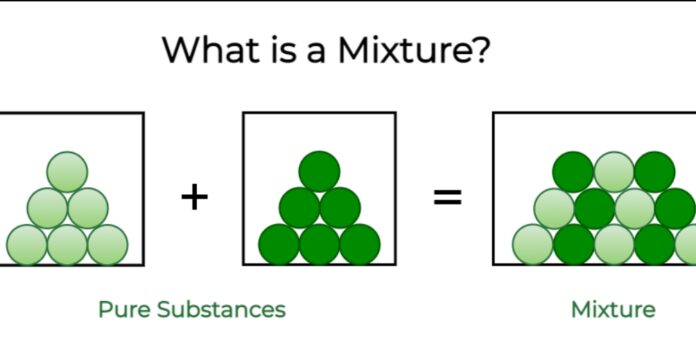In chemistry, when two or more substances mix with each other without participating in a chemical change, the resulting substance is called a Mixture.
The result formed due to the combination of substances does not lose its individuality nor are they combined chemically. Mixtures are the one product of a mechanical blending or mixing of chemical substances such as elements and compounds.
General Properties of Mixtures-
Mixtures are made up of two or more substances that are not chemically combined with each other. The properties of mixtures are listed below.
- The components of a mixture each keep their original properties.
- The separation of components can be easily done.
- The proportion of the components is variable.
Examples of Mixtures
- Crude oil: A mixture of organic compounds (mainly hydrocarbons)
- Seawater: A mixture of various salt and water.
- Air: a mixture of various gases like oxygen, carbon dioxide, nitrogen, argon, neon, etc.
- Ink: A mixture of coloured dyes.
- Gunpowder: A mixture of sulfur, potassium nitrate and carbon.
Types of Mixtures
There are two main types of mixtures: homogeneous mixtures and heterogeneous mixtures. The types of mixtures are discussed below.
- Heterogeneous Mixture
A mixture of sand mixed with salt is an example of a heterogeneous mixture. Heterogeneous mixtures possess different properties and compositions in various parts i.e. the properties are not uniform throughout the mixture.
Examples: air, oil, water, etc.
- Homogeneous Mixture
Sugar mixed with water is the most common example of a homogeneous mixture. Homogeneous mixtures can be defined as the mixtures which possess the same properties and combination throughout their mass.
Examples: alloys, salt, and water, alcohol in water, etc.
Characteristics of Mixtures
The constituents of a mixture are not present in a fixed ratio. The various characteristics of mixtures are discussed below.
- There is no chemical force acting between the two or more substances that are mixed, but they still exist together.
- They can either be heterogeneous or homogeneous in nature.
- The proportions of the substances vary in an indefinite manner.
- The properties of the mixture depend upon the individual components.
- The constituents of the mixture can be separated by physical methods.
- The boiling point and the melting point of the mixture depends upon the characteristic of the constituents.
- During the formation of a mixture, there is no change in energy.
- All the states of matter (solid, liquid, gases) can combine to form mixtures.
It can be concluded that almost everything in our vicinity is nothing but a mixture. For example, the food we eat is a mixture of ingredients, the atmospheric air we breathe is a combination of gases and the fuel we use in locomotives is a heterogeneous mixture.


































